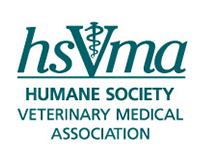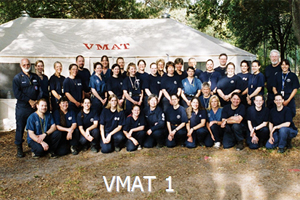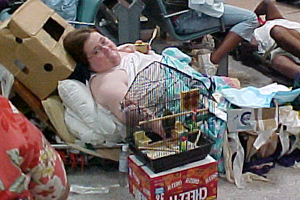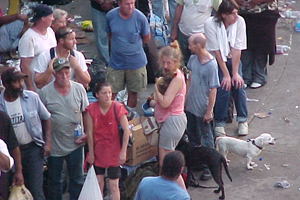|
August 23, 2015 Hurricane Katrina
|
|
This was before Google Maps was accessible on your smartphone. To this day I don’t know how we found our way. It looked like we were heading into a war zone. |
This was before Google Maps was accessible on your smartphone. To this day I don’t know how we found our way. It looked like we were heading into a war zone. The whole area was closed to everyone except the military and rescue workers. The streets were empty, and the destruction was everywhere.
The HSUS response site was in a field near an elementary school. When we got there, the Army was helping erect a large shelter that we used as our base.
At first we had hardly any animals in the shelter. They were still roaming the streets or shut up in houses. Every day we would take care of the animals we did have, and then search streets and houses for animals needing care.
I was amazed by the survivors. I remember one cat who had been shut up in an attic. He was a little dehydrated, but overall he looked pretty good. Later I found out he had previously weighed 20 pounds. I would never recommend starving a cat for a month to get him to lose weight – in fact, most cats in his situation would have died from liver disease – but somehow this guy was just fine.
I also saw a lot of things that broke my heart: The cages of beagles that were stacked on top of furniture to keep them out of flood water. But the flood water went all the way to the roof, drowning them all... The couple who had just completed their new equine facility to provide horses for children with special needs. The water rose so fast that they couldn’t get the barn doors open. Every single horse drowned... One of the worst was a school where people stashed their dogs on the top floor, leaving them with bags of food and notes as to who they were. Someone had gone through and shot and killed every single dog.
But we had some really good saves, too. Dogs that we found starving and nursed back to health. Dogs that were microchipped so we were able to reunite them with their owners, even though they were already halfway across the state. Two weeks after we arrived they started letting residents back in, and we started to see the reunions.
We met a lot of good people. Bobby the firefighter from New York who became an expert in catching dogs off the street. I’ll never forget him hanging out his car window with a come-along, lassoing dogs who were still on the run. He also gave us the best gift. For the first week we were sleeping in the same field as our hospital—a field that had been flooded and was soaked in oil and grime (let’s just call it grime and not think of all the gross things that it really contained). We were eating nothing but Power Bars and “bathing” with baby wipes. Bobby hooked us up with – of all things – a casino boat that was now housing emergency workers. Not only did we get two proper meals a day and a bed, but more importantly, we got showers!
|
I felt a little frantic, worrying about who was going to take over. I was sorely tempted to stay, but my obligations back in my real life had too strong a pull. |
I think if it wasn’t for our jobs back in the "real world," we would have stayed forever. In fact, as our time there ended, the humane agent in charge offered to pay us to stay and continue to run things. I was sorely tempted to stay, but my obligations back in my real life had too strong a pull. I remember feeling a little frantic, worrying about who was going to take over. On our very last day, two more veterinarians showed up, and we handed the reins over to them.
I wasn’t prepared for how I felt coming back home. I went to work but would just come home and sleep, not talking to anyone. For weeks I was a recluse. Later on, while talking to my coworkers, we realized that all three of us had reacted this same way. I think we all went into a depression but being veterinary professionals, we just soldiered on as normally as we could.
I still think about what I would do when the next big disaster hits. Despite everything we saw and experienced, I’m glad I went. I still think about some of the animals I met there and wonder what happened to them after they were shipped off to other parts of the country. I hope and dream that they all found love-filled lives.

The Katrina experience helped me gain a better appreciation for the human-animal bond...
by Carla Huston, DVM, PhD, dipl. ACVPM
Associate Professor, Beef Extension and Outreach Coordinator
Mississippi State University College of Veterinary Medicine
During what time period were you helping with rescue/recovery efforts in the aftermath of Hurricane Katrina?
We were put on alert several days before the storm, and activated by the state veterinarian’s office the day after the storm made landfall. Official activation was August 28 – September 30, although assessments and recovery support continued long after the official state shelter closed and the MS Animal Response Team was demobilized.
Were you representing or working with/for a particular organization while you were doing Hurricane Katrina relief work?
Yes, as an employee of MSU CVM, we were activated under the state’s emergency response plan as part of the Mississippi Animal Response Team under the Mississippi State Veterinarians office.
At what location(s) did you spend most of your time doing rescue/recovery work?
Jackson, Miss. and Hattiesburg, Miss. at the Incident Command Post for the temporary animal shelter and warehouse.
What rescue/recovery activities were you primarily performing?
I served as the veterinary services branch chief for the Mississippi Animal Response Team, coordinating support for private veterinarians as well as animal owners and livestock producers affected by the storm. We provided credentialing for out-of-state veterinarians, organized visiting veterinary and animal shelter teams, and also oversaw the shelter activities in Hattiesburg.
What kind of work were you doing at the time you began Hurricane Katrina relief work?
I was serving as the chair of the MSU CVM animal disaster committee.
What kind of work are you doing now?
I am an associate professor in the Department of Pathobiology and Population Medicine, with an emphasis on veterinary preventive medicine.
Did your experiences around Hurricane Katrina influence/change the kind of work you do now?
Yes, it has increased my involvement with animal and agriculture disaster management activities locally, statewide, and nationally.
How did your professional skills and perspective help or hinder your Hurricane Katrina relief work?
Definitely helped! My professional skills allowed me to help develop intake and triage protocols for animals entering the temporary shelter. Medical knowledge was also needed when allocating donated supplies to the most appropriate locations. Organizational and communication skills also helped direct resources in an efficient and safe manner.
What was your most memorable positive experience during your Hurricane Katrina relief work?
Developing relationships with other responders and community members.
What was your worst experience during your Hurricane Katrina relief work?
Dealing with organizations who self-deployed and would not work with the official state response. This hindered efforts to reunite owners with their pets, and delayed business recovery and continuity for veteriinarians affected by the storm.
|
The MSU CVM continues to be involved in recovery efforts for local and statewide emergencies. |
Have you performed other rescue/recovery work since Hurricane Katrina?
Yes, the MSU CVM continues to be involved in recovery efforts for local and statewide emergencies, such as performing veterinary assessments and shelter support for recent tornado events. We have been activated approximately five times since Katrina, and have provided support for other events involving animal and agricultural issues.
Would you perform rescue/recovery work in the aftermath of another major hurricane or disaster?
The MSU CVM animal disaster committee is committed to supporting local and statewide efforts in animal disaster preparedness, response, and recovery. We routinely provide training in these areas to students, MART volunteers, first responders, and veterinarians.
How did your experiences doing Hurricane Katrina relief work effect and/or change you as a person?
The Katrina experience helped me grow into a better team member as we worked with response agencies and organizations from across the country. I also gained a better appreciation for the human-animal bond in both companion animals as well as farm animals.
What do you think is the lasting legacy of Hurricane Katrina on animals, and our society in general?
The awareness of animal issues, the human-animal bond, and the role of the veterinarian in disaster management. The implementation of the PETS act has greatly contributed to the awareness of animal issues at the local and state levels.
Do you have any final thoughts you would like to share about your experience?
Mississippi had an incident command structure in place prior to Hurricane Katrina, which helped our efforts be more coordinated. Team members knew each other and had a basic understanding of how to manage recovery efforts. Developing relationships with the appropriate emergency managers needs to occur before a disaster event happens. The need for animal response workers to work within the appropriate systems and not self-deploy should be stressed.
|
HSVMA and The HSUS recently gave LSU SVM a $300,000 grant to support their shelter medicine program. Learn more» |
| RAVS' RESPONSE» |
| RESCUE» |
| RECOVER» |
| READINESS» |



